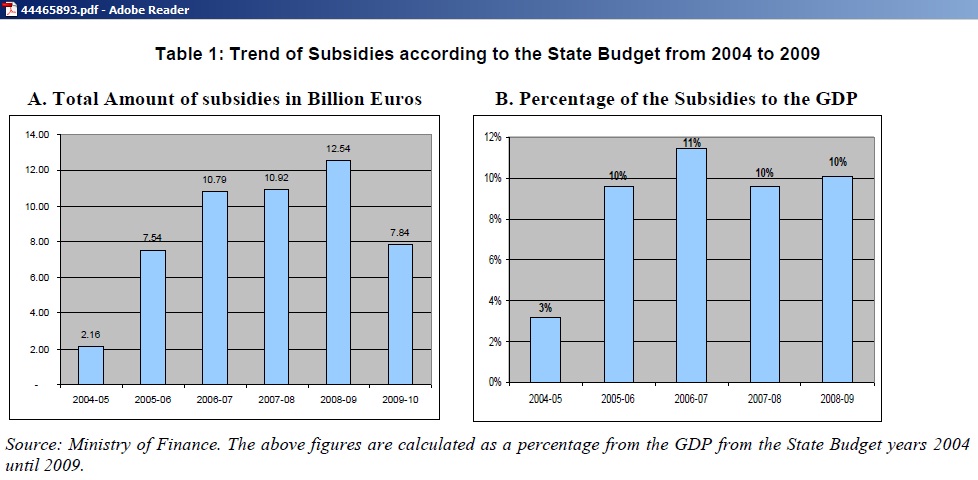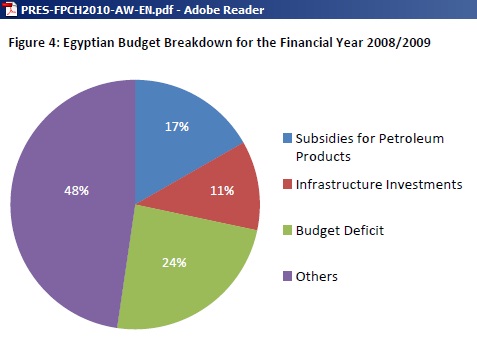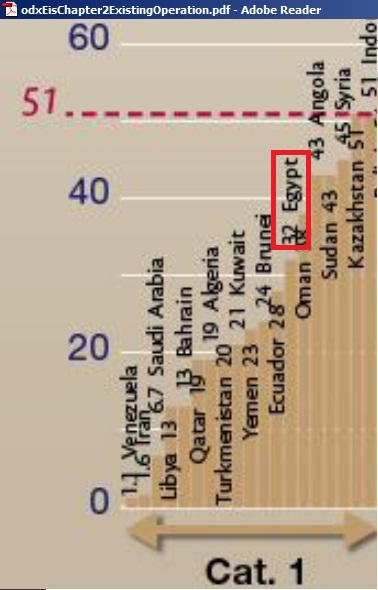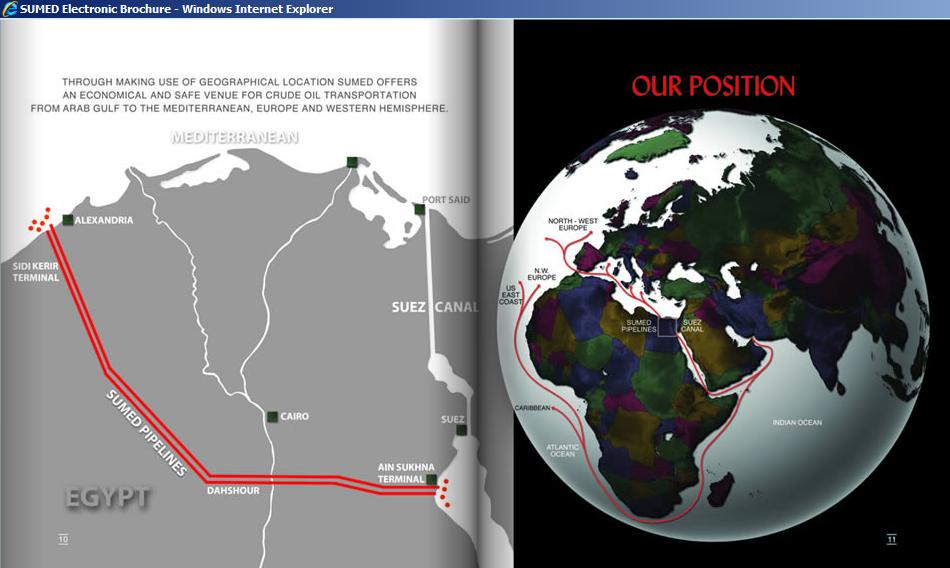Egyptian crude oil production peaked in 1995/96 and declined ever since while at the same time oil consumption increased steadily at around 3 % pa. These conflicting trends have now led to Egypt being a net oil importer with all the socio-economic consequences that entails. Higher oil prices since 2004 have increased 3-fold the cost of subsidies (mainly for petroleum and food) as a percentage of GDP, from 3% to 9%, putting pressure on the nation’s budget. No matter who forms the next government in Egypt, these problems will continue and unrealistic expectations for change could be disappointed. There is a danger that social unrest will impact on oil production and the transit of oil through the Suez Canal and the Sumed pipeline which connects the Red Sea with the Mediterranean.
In this situation, it would be very unwise to plan, finance, start and continue projects which increase oil vulnerability because if the current political movement were to spread to other oil producing countries the world could very soon face a major, irreversible oil crisis. In Yemen just South of Saudi Arabia, for example, crude oil production peaked in 2001 and crude exports are now only half of what they were at their peak.
In Egypt oil consumption has exceeded production levels:
The above graph shows details on the period starting with 1980. Development of natural gas liquids resulted in a temporary rebound of total oil production but nevertheless necessitated import of crude oil. After the Egyptian crude peak in the mid 90s, imports of finished petroleum products started, which are now 1/7th of consumption.
Even if consumption were to stay flat (as a result of removing petroleum subsidies – a hard task for any government) import requirements for crude oil would still increase.
Source of data: http://www.eia.doe.gov/cfapps/ipdbproject/iedindex3.cfm
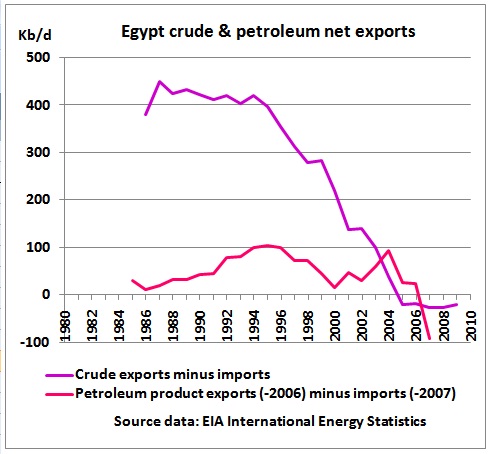 << Egypt is a typical example of the export land model (ELM), see blogspot Graphoilogy
<< Egypt is a typical example of the export land model (ELM), see blogspot Graphoilogy
(1) Oil consumption as a percentage of total supplies was 54% in the peak production year 1996
(2) Crude export decline (-9% pa) is much steeper than production decline (-3% pa)
(3) Crude exports after the peak are front-end loaded: half of all post-peak exports were already consumed after just 3.5 years
(4) It took 10 years for all post-peak exportable crude to be shipped almost completely.
.
.
Future production outlook:
http://www.energyinst.org/home
Petroleum subsidies
The following graph is from an OECD report on Egypt’s “Competition, State aids and subsidies” (Jan 2010, http://www.oecd.org/dataoecd/30/50/44844708.pdf)
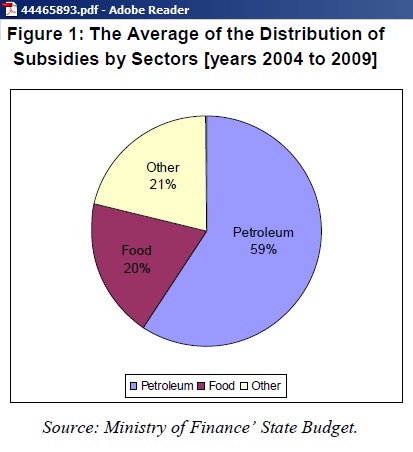 When oil prices went up in 2004, subsidies in terms of percent of GDP tripled in just 1 year. 59% of subsidies relate to petroleum, not only for petrol and diesel, but also for petroleum products used in energy intensive industries like cement, steel, chemicals, fertilizers and aluminium. These subsidies can distort competition and discourage investments in energy efficiencies.
When oil prices went up in 2004, subsidies in terms of percent of GDP tripled in just 1 year. 59% of subsidies relate to petroleum, not only for petrol and diesel, but also for petroleum products used in energy intensive industries like cement, steel, chemicals, fertilizers and aluminium. These subsidies can distort competition and discourage investments in energy efficiencies.
20% of subsidies are used for food and the rest of 21% for other purposes like soft loans, employee training and subsidies to farmers.
http://www.oecd.org/dataoecd/30/50/44844708.pdf
.
.
.
.
In 2008/2009, petroleum subsidies have reached 17% of the budget, more than what is spent on infrastructure.
What’s worse, these universal subsidies are inefficient in protecting the poor from higher fuel prices. A study found that the richest urban quintile receives 33% of fuel subsidies whereas the poorest benefit only from 3.8%.
Subsidies for LPG and kerosene fare better as they are used for cooking by low-income earners.
It is well known that subsidies are misused: “Apparently it has also become a business in Egyptian cities on the Suez Canal to smuggle gasoline and diesel to the ships passing through the canal or through tunnels to the Gaza Strip.”
www.sutp.org/documents/PRES-FPCH2010-AW-EN.pdf
The above budget graph is from a report “Fossil Fuel Prices in the Arab World and the Fear of Reform” (Oct 2010) from GIZ, an international cooperation organisation. GIZ is monitoring fuel prices world-wide for 170 countries and has defined 4 country categories, for a US 51 cents/litre benchmark price (equivalent to $81 a barrel Brent crude)
| Country categories for gasoline by subsidy and taxation | |||
| Cat | Petrol price in US cents | Subsidies or taxation | Retail price of gasoline |
| 1 | 1- 51 | Very high gasoline subsidies | below the price of crude oil on the world market. |
| 2 | 52-76 | Gasoline subsidies | above the price of crude oil on the world market and up to the price level in the US |
| 3 | 77-146 | Gasoline taxation | above the level in the US and up to the price level in Romania, the lowest in EU-27 countries |
| 4 | 147-254 | Very high gasoline taxation | above the price level in Romania |
http://www.gtz.de/de/dokumente/giz2011-international-fuel-prices-2010-2011-data-preview.pdf
Let’s zoom into the above graph:
Egypt is in category 1 (very high subsidies). The retail price of gasoline (left) is very close to the price of crude oil. The retail price of diesel (right) is lower than the price of crude oil
.
Fuel imports as well as crude imports for local refineries have of course to be paid for at world market prices. It will not be easy to lift Egypt’s low petrol and diesel prices to these market rates.
http://www.gtz.de/en/themen/29957.htm
Country categories for diesel:
| Country categories for diesel by subsidy and taxation | |||
| Cat | Diesel price in US cents | Subsidies or taxation | Retail price of diesel |
| 1 | 1- 51 | Very high diesel subsidies | below the price of crude oil on the world market. |
| 2 | 52-84 | Diesel subsidies | above the price of crude oil on the world market and up to the price level in the US |
| 3 | 85-136 | Diesel taxation | above the level in the US and up to the price level in Luxembourg, the lowest in EU-27 countries |
| 4 | 137-203 | Very high diesel taxation | above the price level in Luxembourg |
So the task is daunting:
Since the oil boom in the 1970s, millions of Egyptians, Syrians, Jordanians and Lebanese have been working and living in the Gulf and Libya. After living there for several years, they adapted attitudes to transport that are automobile centered and hence, invested a huge amount of their savings in buying a new car.
Upon returning to their home countries, they expected to be able to continue using their cars cheaply due to low fuel prices and could not comprehend the pressure for higher prices in their home country. They automatically blamed their “incompetent and corrupt governments”.
Moreover, due to the shared media and inter-country traffic, people are used to comparing prices across countries and quickly blame their governments if fuel prices are more expensive at home because – as mentioned earlier – prices are still considered in the domain of the government’s responsibilities.
Subsidies have the strange habit of justifying their existence even when they no longer fulfill the original intention for their introduction. Once there, “interest groups and investments solidify around the existence of the [subsidy] policy and make change difficult”. Consumers invest in gasoline guzzling cars, buy or live on the outskirts of cities far from their work’s location or send their kids to schools halfway across town. Companies plan their logistics around trucks and many households earn their liveability by leasing and driving informal microbuses. These long-term investments make consumers especially from the middle classes vehement opponents to any reforms associated with price increases
Moreover, there is a wide spread feeling in the Arab world that the public is entitled to cheap petroleum products and that “strategic goods” like gasoline and gas have to be subsidized. When rumors spread in Bahrain in August 2010 that the government is considering raising prices of petroleum products demonstrators took to the streets and held banners saying: “Everything but our Food”. It did not help that for years oil ministries propagated their oil discoveries, creating the impression that there is more than enough oil for years and years to come, whether this was true or not. As one talk show host once said to a junior minister from the oil ministry after a price hike:
“You have been giving us the impression for the last 30 years that we are swimming in an oil ocean and now you tell us you have to increase prices.”
And even where oil is available, the public often calls for the reduction of exports if it will lead to lower prices domestically. The public also rarely accepts that oil prices are set internationally and that domestic prices should reflect this fact. National discussions are usually dominated by the view that domestic wages are not set internationally, thus neither should prices.
www.sutp.org/documents/PRES-FPCH2010-AW-EN.pdf
Food subsidies
The Association for Strengthening Agricultural Research in Eastern and Central Africa (http://www.asareca.org/) lists the reasons for increasing food prices (March 2008):
- Strong consumption growth in emerging markets
- Rising global population
- Changing diets from carbohydrates to meat and processed foods
- Increasing urbanisation and rural=>urban migration
- Supply side disruptions: more floods, droughts, diseases and other unusual weather events caused by climate change
Here are some extracts from “Increasing food prices: a call for policy change”
But perhaps the most important drivers of price gains over the past year are developments in world energy markets.High oil prices have encouraged a policy focus on biofuels, including significant subsidies for the development of the biofuels industry in industrialised economies such as the US and the EU.Production has responded quickly to these incentives: the World Bank reports that the US has used 20 per cent of its maize production for biofuels (about 40 metric tonnes of maize or 4 percent of global production of coarse grains) and the European Union 68 per cent of its vegetable oil production reflecting an unprecedented growth in the biofuels industry’s appetite for grains.
This change in usage has boosted prices, reduced the supply of these crops available for food and encouraged the substitution of other agricultural land from food to biofuel production. Demand for alternative energy sources has led farmers to sow less wheat and convert land to crops such as corn, sugarcane and rapeseed, which can be turned into biofuels. But this means there is less land for growing food crops. World grain stocks are at record lows and next year’s prices depend on the success of the next harvest in the northern hemisphere. In seven of the last eight years, world wheat consumption has outpaced production. Stockpiles are at their lowest point in decades.
High prices and extremely tight supplies have prompted leading rice suppliers – including Vietnam, India andEgypt – to restrict exports in recent months in an attempt to keep local markets well-supplied and domestic prices under control while other countries are now seeking assurances over supplies.
In response to increasing food prices, Egypt has widened its food rationing system for the first time in two decades…
The world’s largest importer of wheat is Egypt; currently the government cannot raise the prices of subsidised food, so every increase [in international prices] is absorbed by the state. The bread subsidy alone went up by around $ 820 million last year to reach $ 2.45 billion. Food price inflation has forced the Egyptian government for the first time in 20 years to relax the rules about who can receive subsidised food. As a result, officials say they expect an additional 10.5m people to be added to the list.
www.aaae-africa.org/adverts/PAAPNewsletter-11-5.pdf
There you are. Biofuels are contributing to instability in food importing countries in an area of the world important for global oil supplies. Another example of a negative feed back loop. Biofuels should only be used in the agricultural sector itself, to make it less dependent on oil. Therefore, to waste E10 on the urban motorist (who could use public transport) is a wrong strategy.
Sumed pipeline
Sources of Ain Sukhna deliveries (2004)
Saudi Arabia 65%, Iran 24%, Egypt 6%, Kuwait 4%, Others 1%
Destination of Sidi Kerir lifting:
Eastern Mediterranean 35%, Western Mediterranean26%, NW Europe 34%, US 5%
http://www.sumed.org/docs/Web/index.html
From EIA:
The Sumed pipeline runs 200-miles from Ain Sukhna on the Gulf of Suez to Sidi Kerir on theMediterranean. The Sumed’s original capacity was 1.6 million bbl/d, but with the completion of additional pumping stations, capacity has increased to 2.34 million bbl/d according to industry press. The pipeline is owned by the Arab Petroleum Pipeline Company (APP), a joint venture between EGPC (50 percent), Saudi Aramco (15 percent), a consortium of Kuwaiti companies (15 percent), the International Petroleum Investment Co of Abu Dhabi (15 percent), and Qatar (5 percent). According to APEX, oil flows through the Sumed pipeline in 2009 were 1.1 million bbl/d. This is down considerably from 2008 levels of 2.1 million bbl/d which can also be attributable to the oil market dynamics mentioned above [more oil flows to Asia]. Closure of the Suez Canal and the Sumed Pipeline would divert tankers around the southern tip of Africa, the Cape of Good Hope, adding approximately 6,000 miles to transit time.http://www.eia.doe.gov/cabs/Egypt/Full.html
Choke point Suez Canal
http://www.maritime-executive.com/article/2009-07-09-mcquilling-services-llc-weighs-suez-canal/
Conclusion: the combination of declining oil production, food supply problems and population growth (of a population of 80 million) means that the socio-political change now starting in Egypt will occupy the world for quite some time. While for many it may be interesting news to watch on the TV these developments in the Mediterranean and the Middle East may in the not too distant future become painfully visible at a filling station near you.



